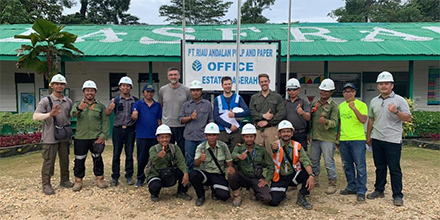
Indufor Group was engaged by Asia Pacific Resources International Limited (APRIL) to undertake an independent review of the strategic wood fibre supply forecast of the company’s commercial plantations supplying PT Riau Andalan Pulp and Paper mill (RAPP) at Riau province, Indonesia. Source: Timberbiz
The review supported APRIL’s aim to ensure transparency and implementation of the company’s Sustainable Forest Management Policy. One of APRIL’s key strategic goals is to reach self-sufficiency of wood supply to the mill from its own plantations.
Indufor carried out an independent review of the components forming APRIL’s Long Range Wood Supply Plan and to give the company’s external Stakeholder Advisory Committee an independent opinion on the reliability of the Plan.
The review focused on three major components forming the wood supply forecast:
- Forest Management Information Systems including the compartment registry, key forest inventory data, tools to plan and execute plantation activities and monitor progress.
- Forest inventory methods examining activities and the data of forest stands structure and growth over time.
- Growth and yield models based on large statistical samples, enabling projection of key tree and forest level parameters over periods of time, for specific tree species and soil types.
Indufor consultants completed a field diagnostics mission in May 2019 at RAPP where they reviewed the relevant business processes with APRIL’s team members, observed inventory procedures, measured randomly selected forest plots and collected relevant data for further analysis.
Throughout the process Indufor identified and evaluated factors affecting the long-term wood supply forecast and assessed their potential impact on the forecast reliability.
Based on Indufor’s review, the data and methodology used for APRIL’s long term wood supply forecast is sound.
Indufor did not observe major shortcomings or inconsistencies that could make the forecast results questionable. Target timeframes for reaching the supply goals is realistic but strict and allow little space for setbacks or recession in growth development.
Current data and information systems offer APRIL reliable tools for continuous monitoring of status and growth of the plantation. Specific strengths were identified in APRIL’s forest inventory procedures where the skillset and tools of their staff are largely comparable to industry’s best practices and provide a reliable basis for accurate large-scale forest inventory.
APRIL has also developed comprehensive growth and yield modelling procedures where the model calibration is based on extensive local data samples of almost 80,000 measured and frequently updated forest inventory plots covering the whole variability of the plantation.
Indufor proposed technical improvements related to the choice of height trees for measurement, automated error checking for data entries, improving the accuracy of the plot location, modelling individual tree parameters and improving the fitting of forest level growth and yield functions.
The key factor in materializing the supply target will be how the average productivity of currently low and mid-productive areas can be raised close to the level of the top productive areas in the following years.
So far, APRIL has achieved increasing growth rates through improved silvicultural activities, replacing Acacia mangium with faster growing and resilient Eucalyptus sp, improved control of pests and diseases and increased coverage of rehabilitation planting of damaged areas.
Key contributing factors to achieving the future plantation productivity target will be maintaining the optimal water table management at every phase of tree growth for Acacia crassicarpa; and the development and choice of correct clones by site type, for Eucalyptus sp.
Indufor was able to provide suggestions for operational improvements.





